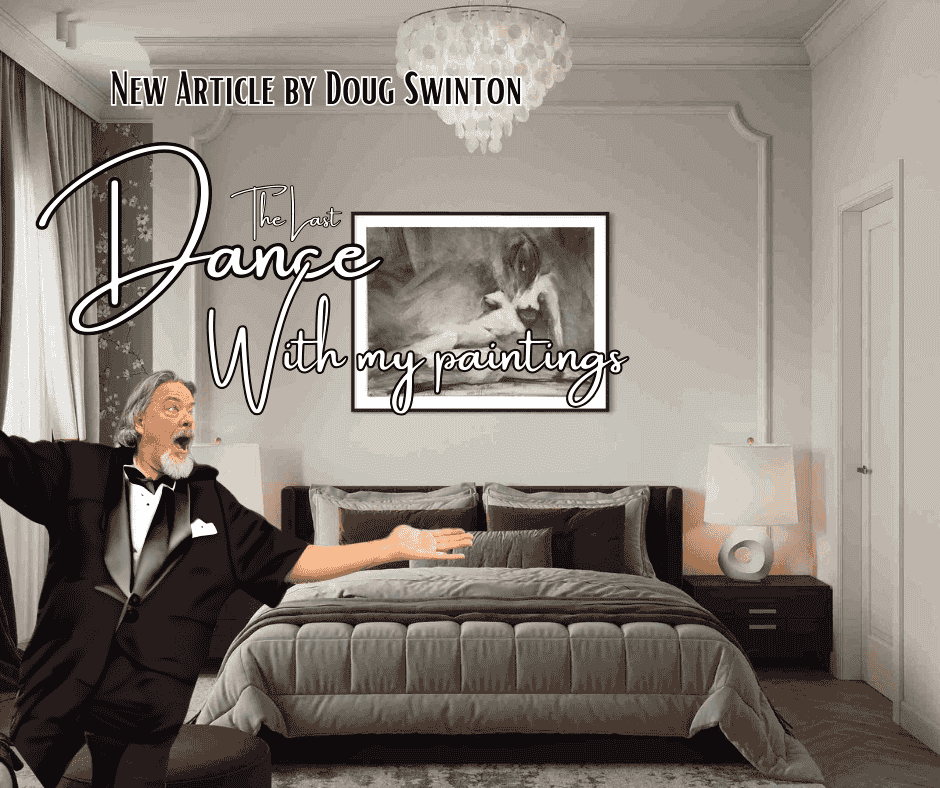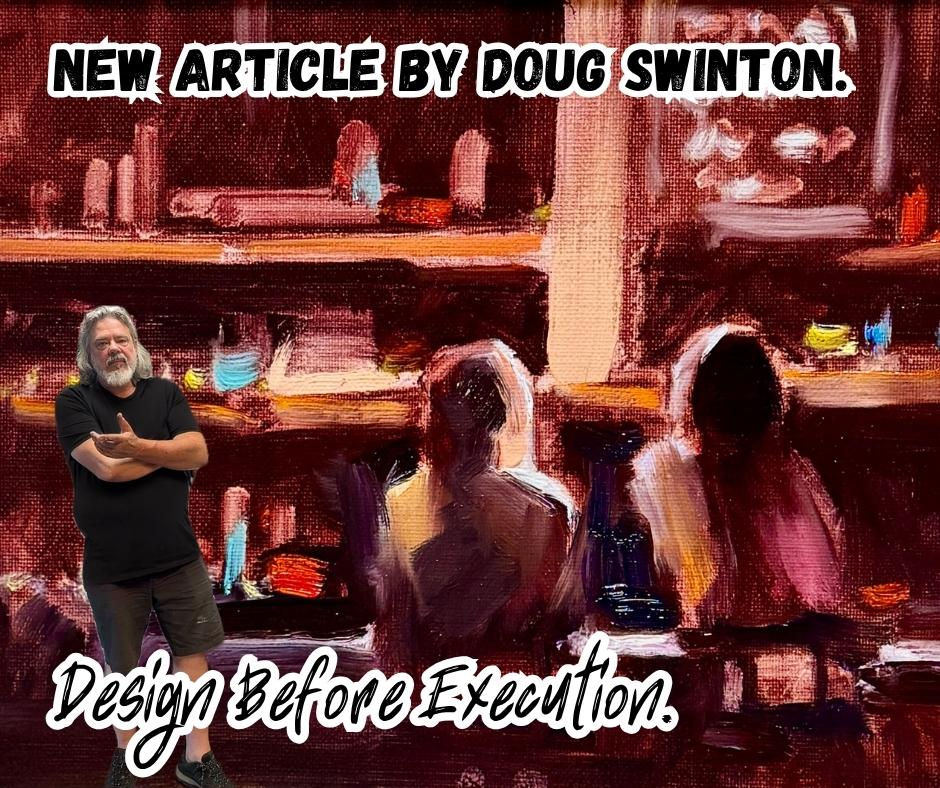The difference between an Artist Statement, a Bio and a CV
- Doug Swinton

- Apr 9, 2019
- 7 min read
Updated: Mar 15, 2021
Wait don't run! This chore can be lots of fun!

All that social media and tweety stuff is hard to sort out. Let’s not go down that path today. Instead, let’s talk about something that is equally important if you’re planning to sell your art on any kind of professional level.
The question about the difference between an artist statement, a bio and a CV is one of the most frequently asked question I receive from my students.
Let’s start by clarifying what each is, what it’s for, and then dive a little deeper into how to put it all together.
In the simplest terms:
A Bio is a personal statement about you.
An Artist Statement is about your art practice.
A CV is an outline of your achievements.
Bio
Your professional artist bio is basically a personal resume in paragraph form and is written in third person. A bio explains who you are as an artist. Your bio should include information about you, how you got started, important accomplishments and anything else you feel is necessary to give people a good look into who you are as an artist.
If written correctly, you bio will give people a greater understanding of you art, and where you came from. A bio is about you and your feelings about art and not the art itself.
You should attempt to make your bio longer than your artist statement, (155 characters give or take), but not too lengthy or wordy otherwise your readers may lose interest.
A few tips on writing a bio.
Should be written in third person.
A short description of your current work.
It is okay to include your past - including art instruction, influences, and what events or upbringing have shaped your artistic direction, etc.
Where you were born and where you live now.
This document should also evolve and change along with your career. More important items will be added as your career grows and less important or less relevant things will be removed. (Where you were born should remain the same, though …hahahah.)
Artist statement
Your Artist Statement is about your art, not about you. It should be written in first person and contain information about the current direction of your work. It is not about your work's history. Your statement should be a brief section of writing that compels the reader to want to view your work and learn more about it within one paragraph. Avoid adding information about teachers or other artworks that have influenced you, save these thing for your bio. Remember that this is your statement, not theirs, so it should only be about you and your current work. By keeping your statement concise and interesting, you should be able to create a successful piece. Try to keep it under 155 characters. This will keep you from rambling on. Your statement should briefly explain your inspirations and motivations of being an artist.
Some things to think about when writing an artist statement.
How would you describe your art?
How are you connected to your art?
A brief description of how you create your art should be included in your statement. You could also, in one or two sentences describe your techniques.
What makes your art unique?
What message do you want to get across with your art?
What is your artistic style?
What inspires you to create art?
Be personal. This can be difficult for some people. Revealing something personal might be the most difficult part of writing your artist statement.
At the same time remember that you do not need to describe everything about your life.
CV "Curriculum Vitae"
An artist CV tells a reader at a quick glance whether you are the right fit for a gallery, grant submission or a possible exhibition. In short, the CV is a single-page summary of your most important experiences and accomplishments.
Often confused with a resume; a typical form that is used for job applications, a resume explains your skills and experience, and the main focus is on personal qualifications, such as education and work history. A CV, in contrast, is more of a record of accomplishments such as exhibitions, publications, and awards.
For most situations, a CV is good for an artist, as it conforms to a format that lends itself well to displaying an exhibition history.
A few thing to keep in mind when writing a CV
The ideal length for a CV is 1-2 pages.
If you've been working internationally for over 20 years, you can certainly push it to three, but most galleries and competitions are really looking for 1-2 pages at most. Remember, the CV is a summary, not a biography. You should keep everything consistent across the board with your submissions. That includes font and style. If you bold certain items (like sections) or italicize others (like titles of shows), be sure to be consistent throughout the entire document.
Many elements of your CV will be lists (of exhibitions, awards, publications), and it will be tempting to bullet or number these lists. Do not use bullet points or numbers. These can be distracting and confusing and will pull attention away from the information that you are trying to convey.
Header
CV should have your name and contact information right at the top. Include: name, e-mail, website, phone number, and primary address. Give your reader every option to contact you. The more ways to contact you, the better.
Your name should be the very first thing that any reviewer sees, either centred or aligned to the left of the page. You can adjust the type size to make it larger than the rest of your contact information. At a glance, your name is the first thing to stand out.
Education.
If you have formal training as an artist, such as a BFA, MFA, or a design degree, be sure to list your education next on the page. People like to see what you studied, where, how long ago, and who your teachers were. If you went to a well-known or prestigious art school, like "Swinton's Art Instruction." This can often be a great highlight of the CV. These items look best in chronological order, with the most recent at the top
The education section should look like this:
Name of School - Degree Achieved - Year Achieved
Name of Other School -Degree Achieved- Year Achieved
Workshops attended
Teacher's studied under.
There is no do-or-die requirement for all the information you need to include in an artist CV, so you can leave off things you do not feel apply to a given situation or outdated items. On the other end, you can add achievements that you feel need their own category. Regardless, if you can't fill a section adequately, don't include it. Having a blank header implies a lack of experience, even if you do have experience in other sections.
Exhibition History
There are two ways to go about this section, and they both depend on the length of your exhibition history.
If you have participated in fewer than 10 show, include your entire exhibition history and label this section as "Exhibition History."
If you have more than 10 shows, include a selected exhibition list. Title this section "Selected Exhibition History."
The longer your career, the more likely it is you'll want to include selected exhibitions, as too much information will bog down your CV and lessen the impact the over all CV will have. That's why I recommend 15-20 shows as the maximum. When you find your CV filling up with more than 15-20 entries, parse it down to keep only the most notable galleries or shows.
If you have more than 5 solo exhibitions, separate them into their own category. For fewer than 5 solo exhibitions, include them with the rest of your exhibition history, but make sure to clearly label them as solo shows.
You must have this essential information for each exhibition entry:
Year (always put your most recent exhibition first!)
Gallery Show Competition Name
Title of Show (looks best in quotation marks or italics)
City, province and country.
You can put the information in whatever order you think will make sense to your reader, but remember, it must be clear and consistent. A reader has to know when, what, and where your experiences happened, and the template above fills in all the blanks. The more information you give per entry, the easier it is for the reader to do a search and find out more, but just keep your entries to 1-2 lines max per show.
Collections
Next up is a list of institutions and collections in which your work is held. An institution is a museum or school. A public collection is a collection that is not necessarily a museum but can be viewed by the public, such as in a government or corporate office. This is opposed to a private collection, wherein the works are held by an individual buyer in their home or private place of business.
The information you should have for each entry is:
Name of Artwork
Name of Collection/Institution
Location (City, Country)
Year Acquired or Donated
Do not use bullet points or numbers.These can be distracting and confusing, and will pull attention away from the information that you are trying to convey.
The entry can be arranged like so:
Artwork Title. Swinton Art Museum. Dougvilleville, Alberta. Purchased. 2015.
Publications
Next comes a list of the publications that you've been featured in. This can be any publication, big or small, but if you're only including a select few entries then be sure to favour the "best looking" publications. Print media is still favoured over the web for these kinds of things and will look better on your CV.
Just like your exhibitions, you'll want to list the most recent publication at the top, and the rest in reverse chronological order beneath.
Your entries should look something like this:
"Title of Article." Title of Publication . Volume number and publication date.
Affiliations & Memberships
This final section will feature arts or arts-related organizations of which you are a member. It can be anything from an international group of artists to a small arts circle in your community.
Footer
At the very bottom will be your footer, in which you can include the name and information of any galleries that you are represented by at the time you publish your CV. In typical footer-style, this looks nice centred and a few points smaller than the rest of the document.
It should look something like this:
Current Representation: Gallery Name, City, province state, Country. Website and/or phone number.
Important Note
Remember that a curriculum vitae is a living breathing document and should be updated with every new show, new award or change in personal information.

I know this can be tedious work. It's the nasty side of art business. But if you treat it as professionaly as you treat your painting, you're sure to score some gigs, make some sales, perhaps even find representation with a gallery.
Keep those brushes swinging!
Your friend in art,
Doug.








knowing how to get an online job means combining adaptability with recognised academic or professional training. remote work often requires evidence of capability and responsibility. education supports steady career progression. the college of contract management provides relevant learning opportunities tailored to online roles.
Through The College of Contract Management’s resources, professional development is described with a focus on clarity and structure. Conversations about employment naturally touch on the average monthly wage in uk, which sits roughly between £2,200–£3,700 for standard roles.
bejototo
situs toto
sontogel daftar
sontogel daftar
Ready for some fast-paced fun? Doodle Baseball is the ultimate time-killer! Tap to swing and time your hits to perfection in this charming, challenging Doodle Baseball game.